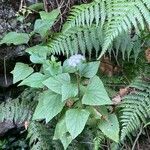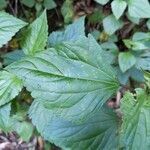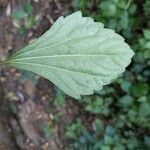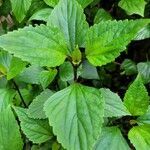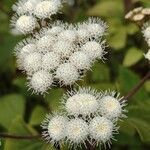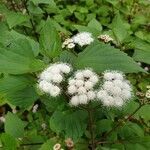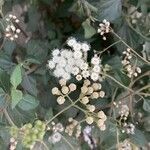Shrubs or perennial herbs, 30-90(-200) cm tall. Stems erect; branches opposite, obliquely ascending, white or ferruginous puberulent, upper part and peduncles more densely so, glabrescent or glabrous in lower part by anthesis. Leaves opposite, long petiolate; blade abaxially pale, adaxially green, ovate, triangular-ovate, or rhombic-ovate, 3.5-7.5 × 1.5-3 cm, thin, both surfaces sparsely puberulent, more densely so abaxially and on veins, basally 3-veined, base truncate or slightly cordate, margin coarsely crenate, apex acute. Synflorescences terminal, corymbose or compound-corymbose, to 12 cm in diam. Capitula numerous, 2-4 cm, 40-50-flowered; involucre broadly campanulate, ca. 3 × 4 mm; phyllaries 2-seriate, linear or linear-lanceolate, 3.5-5 mm, apex acute or acuminate; receptacle convex to conical; corollas purplish, tubular, ca. 3.5 mm. Achenes black-brown, narrowly elliptic, 1-1.5 mm, 5-angled, without hairs and glands; pappus setae 10, basally connate, white, fine, equal to corolla. Fl. and fr. Apr-Oct. 2n = 51.
Erect perennial herb to subshrub, 1-3 m tall. Stems densely clothed in stalked glandular hairs at least above, sometimes also with eglandular hairs, sometimes tinged purple, much-branched. Lvs opposite; petiole glandular, 15-35-(50) mm long; lamina glabrescent to minutely glandular especially on veins of lower surface, ovate-rhombate to deltate, acute to acuminate, coarsely crenate-serrate except near base, 55-80-(120) × 35-70-(90) mm; uppermost lvs smaller, often ± elliptic and entire. Capitula 5-7 mm diam., numerous in terminal corymbs; peduncles densely glandular. Involucral bracts in 2 ± equal rows, with shorter, narrower supplementary bracts outside, narrow-elliptic to lanceolate, glandular, 4.5-5.5 mm long. Florets white. Achenes black, 5-angled, glabrous, 1.3-1.8 mm long.
Herb or sometimes a subshrub, with a short rootstock, normally 0.5–1 (–2) m high; stems erect or decumbent, fleshy, brittle, purplish, densely glandular-pubescent in upper parts. Leaves with petioles 10–50 mm long; lamina deltoid to rhombic (rarely ovate), 30–120 mm long, 15–70 (–100) mm wide, obtusely cuneate to truncate at base, coarsely crenate to serrate, shortly glandular-pubescent on abaxial veins, ±glabrous adaxially, discolorous. Capitula 4–8 mm diam., numerous, in erect, dense, terminal corymbs; involucral bracts in 2 or 3 series, narrowly elliptic to lanceolate, 3–4 mm long, glandular, 2-or 3-veined. Corollas 3–4 mm long. Achenes c. 1.5–2.5 mm long, 5-ribbed, glabrous, dark grey or black. Pappus bristles 5–10, 3–4 mm long, scabrid. [See also Green (1994: 403).]
Subshrubs, 50–220 cm. Stems (usually purplish when young) erect, stipitate-glandular. Leaves opposite; petioles 10–25 mm; blades (abaxially purple) ovate-lanceolate or ovate-deltate to lanceolate-ovate, (1.5–)2.5–5.5(–8) × 1.5–4(–6) cm, bases cuneate to obtuse or nearly truncate, margins serrate, apices acute to acuminate, abaxial faces stipitate-to sessile-glandular. Heads clustered. Peduncles 5–12 mm, densely stipitate-glandular and sometimes also sparsely viscid-puberulent. Involucres 3.5–4 mm. Phyllaries: apices acute, abaxial faces stipitate-glandular. Corollas white, pink-tinged, lobes sparsely hispidulous. Cypselae glabrous. 2n = 51.
A well-branched, glandular-pubescent perennial herb up to 1 m tall. Leaves opposite, ovate or rhomboid, up to 10 x 6 cm, triplinerved, apex acute to acuminate, base broadly cuneate, margins crenate, petiole up to 4 cm. Heads campanulate, c. 5 x 5 mm, crowded in corymbs terminating the twigs and short stiff lateral branches. Involucral bracts biseriate, lanceolate, glandular-pubescent. Flowers white. Achenes c. 2 mm long, subcylindric, smoothly 5-angled. Pappus of numerous scabrid bristles.
A herb or shrub. It grows 1-2 m tall. The leaves are opposite and trowel shaped. They have teeth along the edge. The leaves are 6-10 cm long by 3-6 cm wide. The flower is compound and occurs in clusters at the ends of the branches. The seed is small and brown and feathery.
Perennial herb, up to 1 m high. Leaves, stems and inflorescence branches densely glandular-hairy. Leaves opposite, ovate to rhomboid. Involucral bracts in 2 or 3 series, subequal. Heads ± 5 mm long. Achenes glabrous. Flowers white.
